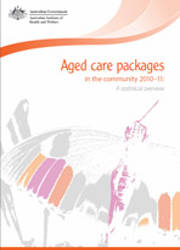Summary
This report presents statistics from July 2010-June 2011 about three types of community aged care programs: Community Aged Care Packages (CACP) and Extended Aged Care at Home (EACH) and Extended Aged Care at Home Dementia (EACHD). CACPs are considered to be low‑care packages, and the others high‑care. Together with its companion report Residential aged care in Australia 2010-11: a statistical overview, this report provides an overview of Australian Government‑funded aged care.
More high-care packages
The overall number of operational packages at 30 June 2011 was 57,922, an increase of 13% on the number at 30 June 2010. The corresponding increases in the programs were CACP (6%), EACH (46%) and EACHD (55%). There were a total of 8,150 EACH packages and 3,995 EACHD packages.
More women than men receive packages and men start and leave packaged care earlier
Women make up a greater proportion of clients than men (70% for CACP, 63% for EACH and 61% for EACHD). For low‑care packages, 16% of women were aged under 75, compared with 23% of men, whereas 44% of female and 38% of male clients were aged 85 or over. This pattern was also evident for high‑care clients.
Clients on high-care packages are likely to have carers who live with them
High‑care package clients were likely to have carers: 65% of EACH clients had co‑resident carers and a further 28% had non‑resident carers. Correspondingly, 73% of EACHD clients had co‑resident carers, and 19% had non‑resident carers. About 54% of CACP clients lived alone, consistent with their lower needs for care.
The care needs of high-care recipients changed more quickly than those of low-care clients
About 62% of EACH and 66% of EACHD clients were on packages for less than two years whereas only 48% of CACP clients remained on packages for the same length of time. Most women left packages due to changing care needs or circumstances or to enter residential care, while most men left due to death.
Providers mainly not-for-profit
The majority of approved providers were from the not‑for‑profit sector. Proportions of not‑for‑profit services varied between states and territories from 72% to 93%, with the Australian average being 77% for CACP. In high‑care, 86% of EACH and 89% of EACHD services were supported by‑not‑for‑profit providers.
Different patterns of use by Aboriginal and Torres Strait Islander people
People who identify as Aboriginal and Torres Strait Islanders tend to use community aged care services at a higher rate and at younger ages than non‑Indigenous people. For example, Indigenous clients aged 60-64 used CACPs at a rate of 18.2 per 1,000 persons, compared with 0.5 per 1,000 for non‑Indigenous clients.
In addition, 37% of Indigenous CACP clients were under 65, compared with 2% of non‑Indigenous clients indicating higher health and care needs at younger ages and the availability of packages to meet this need.
Preliminary material: Acknowledgments; Abbreviations; Summary
Introduction
- Aged care in Australia
- Package of aged care reforms released in 2012
- The purpose of this report
- Overview of community aged care in Australia
- Data sources a and organisation of the report
- Changes to the 2010-11 report
Community aged care programs and service provision
- Characteristics o of service outlets
- Characteristics and a availability of packages
Client characteristics
- Numbers of clients
- Age and sex profiles of clients
- Client background
- Client living arrangements
- Community a aged care clients and carers
Special needs groups
- People in rural and remote areas
- Aboriginal and Torres Strait Islander people
- People from non-English s speaking backgrounds
Patterns of use
- Admissions
- Separations
- Separation modes
- Length of stay
- Leave types and use across packages
Trends in community aged care
- Increases i in the number of packages
- The number and distribution of admissions
- The number and distribution of separations
Appendix A: Online tables
Appendix B: The reporting environment for community aged care
Appendix C: Data sources and limitations of the data
End matter: Glossary; Care recipients' details; Care recipients' admission a and separation details; Service providers' details; Limitations of the data; References; List of tables; List of figures; List of boxes



